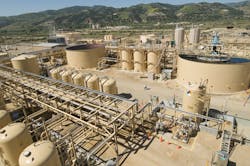By Jeff Gunderson
Meaningful advancements in purification technologies have allowed for significantly higher standards of industrial wastewater treatment while also expanding opportunities for reusing water in a growing variety of capacities. This is especially evident in the conventional sector of the oil and gas industry, where a combination of key drivers and the availability of increasingly robust and cost-effective treatment processes are spurring more initiatives that seek to maximize the amount of produced water and refinery wastewater that can be reused for beneficial purposes.
Oil companies have started to realize the importance of water in the industry and are developing new methods to reduce freshwater consumption as well as increase cost savings and sustainability, according to a market research report from TechNavio that evaluated the global water management services market for the oil and gas industry. Operators are extensively reusing oilfield wastewater and especially produced water with an aim to reduce operational risks, capital and operating expenditure, and assuage shareholders’ concerns, TechNavio found.
Reuse of produced water in conventional oil and gas operations includes water-intensive enhanced oil recovery (EOR) techniques, which are used to drive out the last remaining hydrocarbons from previously drilled and extracted conventional sources. But while increasingly more common, treating produced water for EOR still presents a number of key challenges, said Scott Barrie, managing director of H2 Oil & Gas, an Aquarion Group company based in the UK. “Each reservoir is different and EOR needs will vary through the life of the reservoir. Therefore, a cost-effective and flexible system is the holy grail,” he said.
In upstream U.S.-based conventional oil and gas production operations - the vast majority of which are located in the western U.S. and California - produced water volumes are much larger as compared to unconventional operations, providing a substantial opportunity for recycling, said Lnsp Nagghappan, senior director of business development with Veolia Water Technologies specializing in the oil and gas upstream produced water market. “For every barrel of oil, about 10 to 20 barrels of water are produced, and as much as 30 to 50 percent of this produced water is currently reused for EOR such as steam and water flooding applications,” he said.
In California, it is common practice for excess produced water that cannot be reused in process operations to be disposed of via Class-II deep well injection, a method that presents significant issues, according to Nagghappan. “Injecting produced water into deep wells can cause reservoir formation pressures to increase, which limits production,” he said.
Plus, with regulators shutting down hundreds of injection wells and hundreds more targeted for closure, California’s capacity for deep well disposal is becoming increasingly limited. “For these reasons, producers are very motivated to find reliable alternate disposal solutions with high uptime availability,” Nagghappan said.
Treating excess produced water for reuse is a growing, key target area of opportunity in California, where severe drought continues to plague the state and stress the availability of long-term water supplies. In Oil and Gas Produced Water Management and Beneficial Use in the Western United States, a report from the U.S. Department of the Interior and the Bureau of Reclamation, produced water - if appropriately treated and managed as a resource rather than a waste for disposal - can serve as a water supply in drought-prone regions of the western United States, with uses including crop irrigation, livestock watering, streamflow augmentation, aquifer recharge, and industrial applications.
Veolia is behind two projects in California that treat oil field produced water for beneficial discharge and irrigation use. In San Ardo, Veolia designed an advanced water treatment system for Chevron that treats 50,000 barrels per day (bpd) of produced water for discharge to recharge basins and production of once-through steam generator (OTSG) make-up water. Employing Veolia’s OPUS technology - an elevated pH reverse osmosis technology with pretreatment - Chevron was able to convert excess oil field produced water into a freshwater quality suitable for discharge to recharge basins. Veolia’s other project, located at the Arroyo Grande Oilfield in San Luis Obispo, is a 50,000-bpd water reclamation facility that treats produced water for surface discharge and generation of OTSG make-up water. The facility incorporates Veolia’s OPUS II technology, an improvement of the first generation process with the inclusion of ceramic membranes for producing high-quality reclaimed water.
In addition to reducing salt levels in produced water, Veolia’s OPUS technology is specifically designed to remove boron - which is highly toxic to plants - enabling discharge and irrigation use.
“Due to current market conditions and low commodity oil prices, the industry has not yet fully adopted treatment of excess produced water for surface discharge on a macro level, but because of capacity limitations with Class-II disposal wells and California’s drought situation, this could soon change,” Nagghappan said. “In the years to come, there will be more and more necessity to treat excess produced water for discharge in an effort to minimize deep well injection.”
Potential for Large-Scale Produced Water Reuse
In Wasco, Calif., a demonstration project was recently conducted to evaluate the performance and economic feasibility of treating produced water from oil fields for large-volume agricultural reuse. Developer Sweetwater Tech Resources aims to build several regional water reuse facilities, and to prove the concept, the project employed Los Angeles-based Water Planet’s IMS-5000 Integrated Produced Water Treatment Solution powered by IntelliFlux, an integrated mechanical and membrane filtration system that utilizes ultrafiltration membranes and artificial intelligence (AI) software that works to optimize system performance.
Engineered to address the complexity of produced water - one of the most challenging water treatment applications - the IntelliFlux AI software automatically adapts and adjusts flux maintenance protocols in real time as influent quality and/or membranes change over time, ensuring stable system performance with maximum water recovery, process uptime and filter media useful life.
“The algorithms, learning functions, and predictive analytics of the AI technology perform on a similar level to what a crew of operators and plant engineers would provide,” said Eric Hoek, CEO of Water Planet. “It evaluates data in real time while factoring in historical data trends and previous cause-and-effect relationships to continually respond in the most optimum way.”
The pilot tested the capacity of the filtration system for treating 10 different produced waters from a consortium of California oil producers. Results from the demonstration showed that all water quality criteria specified for reuse could be achieved, according to Hoek.
“In California, we have a unique combination of drought, deep well shutdowns, massive volumes of available produced water, and a region that is desperate for new water supply options,” said Hoek. “The opportunity is immense, the technology exists, and the economics for treating produced water for reuse are favorable.”
Indeed, with the spot market for water now as high as $1,500 per acre-foot, Hoek said the drought has enabled the opportunity for reuse from a financial perspective. “We can now treat produced water for reuse at a cost that makes sense,” he said.
With the pilot phase complete, Hoek expects that a project will soon be approved to build an industrial-scale facility providing up to 10,000 barrels per day of produced water treatment for a range of industry end uses including agricultural irrigation.
Refinery Wastewater Reuse
Advanced recycling projects are also evident in the downstream segment of the oil and gas industry. In Regina, Saskatchewan, Canada, the Co-op Refinery Complex will soon be North America’s first refinery to recycle all wastewater for internal use. Driven by water use restrictions mandating that a new source of water be utilized, the refinery will install a solution from GE Water & Process Technologies that employs the ZeeWeed membrane bioreactor (MBR) technology in combination with a high-efficiency reverse osmosis (HERO) system for treating and reusing 2 million gallons of wastewater per day for steam production, which in turn will be used for heating, hydrogen production, cooling towers, and to power equipment.
“The project addresses the issue of water scarcity and enables the refinery to establish a more sustainable water balance,” said GE Water and Process Technologies Region Executive Paul Schuler. “Refinery processes use a lot of water but by achieving 100 percent wastewater recycling, the Co-op Refinery will effectively reduce freshwater withdrawals by 28 percent - the equivalent of what 3,100 households in Regina would use on an annual basis.”
Jeffrey Zurlo, global marketing strategist for refining, also with GE Water and Process Technologies, said the combination MBR and HERO solution was specifically chosen for the project to address the extreme variability of today’s refinery wastewater. “As crude oil supplies are increasingly blended, causing crude quality to become more diverse, greater variability is introduced into the process wastewaters,” Zurlo said. “Managing that variability is one of the big challenges that refineries face.”
However, advancements in instrumentation, enabling for measurement sensors and controls that provide more visibility with data, are tools that can help refineries overcome this challenge, Zurlo said. “The availability of cloud-based platforms that connect data to performance systems in real time allow treatment operations the flexibility and efficiency to respond to changes or to capture the one-off events that could upset operations,” he said.
About the Author: Jeff Gunderson is a correspondent for Industrial WaterWorld. He is the founder of Waterstone Writing (waterstonewriting.com), a specialized content provider with a core focus in water, technology, energy and sustainable solutions. Jeff is also a part-time faculty instructor at Portland State University, teaching in the Professional and Technical Writing program. He holds a master’s degree in Environmental Science and Engineering from the Colorado School of Mines and a bachelor’s degree in General Science from the University of Oregon.





